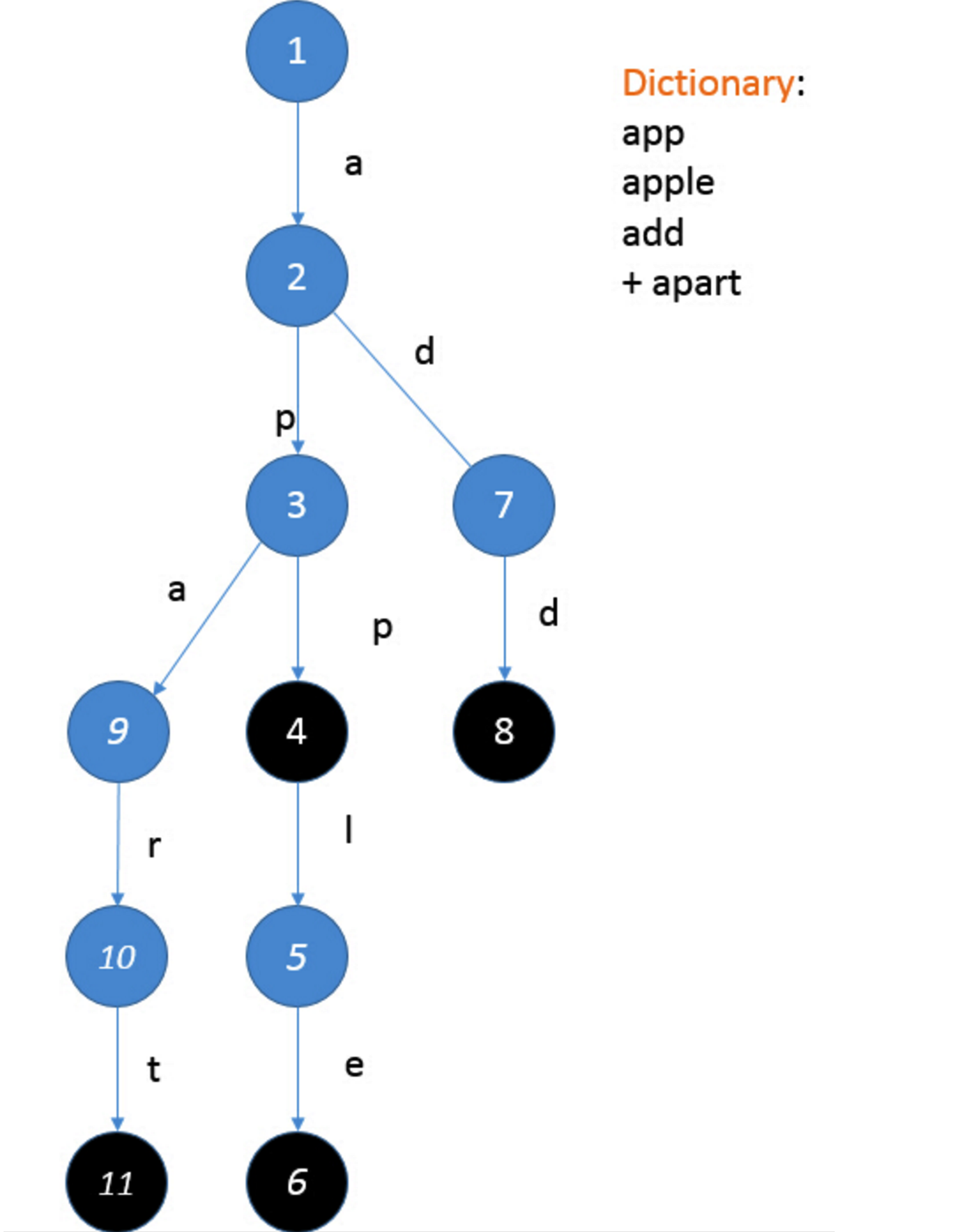数据结构 - Trie树(字典树)
2016-04-11 15:57
671 查看
Trie树
代码实现
无多余空间版本
树的大致结构如下图所示:

从上到下的节点,公共前缀只保存一次。
其实本来实现比较简单,我为了可扩展,所以特意写的复杂了一点。
下面一个是用链表存储内容的,这样节省空间,只是提高了一定程度上的复杂度。
解决了Hihocoder上面的Trie树
代码实现
无多余空间版本
Trie树
也叫单词查找树或者字典树,Trie树,是一种树形结构,是一种哈希树的变种。典型应用是用于统计,排序和保存大量的字符串(但不仅限于字符串),所以经常被搜索引擎系统用于文本词频统计。它的优点是:利用字符串的公共前缀来减少查询时间,最大限度地减少无谓的字符串比较,查询效率比哈希树高。树的大致结构如下图所示:

从上到下的节点,公共前缀只保存一次。
代码实现
//
// main.cpp
// TrieTree
//
// Created by Alps on 16/4/9.
// Copyright © 2016年 chen. All rights reserved.
//
#include <iostream>
#include <cstring>
#include <string>
using namespace std;
#ifndef BranchNum
#define BranchNum 26 //记录每个节点的孩子节点最多数量
#endif
class Alps_Trie{
public:
Alps_Trie(){
root = new TreeNode();
}
void addNode(string str){
TreeNode *node = root;
for (int i = 0; i < str.length(); i++) {
int pos = transToInt(str[i]);
if (node->children[pos] == NULL) {
node->children[pos] = new TreeNode();
}
node = node->children[pos];
}
if (node->flag == 0) {
node->flag = 1;
}
}
bool searchTree(string str){
TreeNode * node = root;
for (int i = 0; i < str.length(); i++) {
int pos = transToInt(str[i]);
if (node->children[pos] == NULL) {
return false;
}
node = node->children[pos];
}
if (node->flag != 0) {
return true;
}
return false;
}
private:
/**
* 字典树节点结构
*/
struct TreeNode {
int flag; //记录单词信息
TreeNode * children[BranchNum];
TreeNode(){
for(int i = 0; i < BranchNum; i++){
children[i] = NULL;
}
flag = 0;
}
};
/**
* 把每个节点要存储的数据转换成int
*
* @param ch 字符
*
* @return 返回下标
*/
int transToInt(char ch){
int temp = ch - 'a';
return temp;
}
/**
* char to string
*
* @param arr char
*
* @return string
*/
string transCharToString(char *arr){
return string(arr);
}
string transIntToString(int num){
char alps_temp;
string alps_str = "";
while (num) {
alps_temp = num%10 + '0';
alps_str += alps_temp;
num/=10;
}
return alps_str;
}
TreeNode * root;
};
int main(int argc, const char * argv[]) {
Alps_Trie* root = new Alps_Trie();
string str;
cout<<"Please input words in dictionary"<<endl;
for (int i = 0; i < 3; i++) {
cin>>str;
root->addNode(str);
}
cout<<"Please input words you want to search"<<endl;
cin>>str;
if(root->searchTree(str)){
cout<<"YES"<<endl;
}else{
cout<<"NO"<<endl;
}
return 0;
}其实本来实现比较简单,我为了可扩展,所以特意写的复杂了一点。
无多余空间版本
前面写的是使用数组来定义孩子节点,这样查找速度变为O(1),但是这样有个问题,假如是多叉树,是很容易内存过高的。因为一个节点只有一个孩子,还是要申请最多孩子的空间数量。下面一个是用链表存储内容的,这样节省空间,只是提高了一定程度上的复杂度。
解决了Hihocoder上面的Trie树
#include <iostream>
#include <cstring>
#include <string>
using namespace std;
/**
* 字典树节点结构
*/
struct TreeNode {
int flag; //记录单词信息
char ch;
TreeNode *left;
TreeNode *down;
TreeNode(){
flag = 0;
left = NULL;
down = NULL;
}
TreeNode(char c){
ch = c;
flag = 0;
left = NULL;
down = NULL;
}
};
class Alps_Trie{
public:
Alps_Trie(){
root = new TreeNode();
}
void addNode(string str){
TreeNode *node = root;
for (int i = 0; i < str.length(); i++) {
if(node->down == NULL){
node->down = new TreeNode(str[i]);
node = node->down;
node->flag += 1;
continue;
}
TreeNode *next = findChar(node->down, str[i]);
if(next == NULL){
next = new TreeNode(str[i]);
node = node->down;
next ->left = node->left;
node->left = next;
node = next;
node->flag += 1;
}else{
node = next;
node->flag += 1;
}
}
}
int searchTree(string str){
TreeNode * node = root;
for (int i = 0; i < str.length(); i++) {
TreeNode* next = findChar(node->down, str[i]);
if(next == NULL) return 0;
node = next;
}
if (node->flag != 0) {
return node->flag;
}
return 0;
}
TreeNode * findChar(TreeNode *node, char c){
TreeNode * temp = node;
while(temp != NULL){
if(temp->ch == c){
return temp;
}
temp = temp->left;
}
return temp;
}
private:
TreeNode * root;
};
int main(int argc, const char * argv[]) {
Alps_Trie root;
string str;
int M,N;
cin>>M;
for (int i = 0; i < M; i++) {
cin>>str;
root.addNode(str);
}
cin>>N;
for (int i = 0;i < N; i++){
cin>>str;
cout<<root.searchTree(str)<<endl;
}
return 0;
}
/*
测试数据:
5
babaab
babbbaaaa
abba
aaaaabaa
babaababb
5
babb
baabaaa
bab
bb
bbabbaab
求得的是公共前缀的字符串数量,上面5个是插入的字符串,下面5个是查找的
*/
相关文章推荐
- 微信搜一搜迈出新的一步,好戏来了
- C#数据结构之顺序表(SeqList)实例详解
- Lua教程(七):数据结构详解
- 解析从源码分析常见的基于Array的数据结构动态扩容机制的详解
- C#数据结构之队列(Quene)实例详解
- C#数据结构揭秘一
- C#数据结构之单链表(LinkList)实例详解
- 数据结构之Treap详解
- 用C语言举例讲解数据结构中的算法复杂度结与顺序表
- C#数据结构之堆栈(Stack)实例详解
- C#数据结构之双向链表(DbLinkList)实例详解
- JavaScript数据结构和算法之图和图算法
- AJAX 支持搜索引擎问题分析
- Java数据结构及算法实例:冒泡排序 Bubble Sort
- 搜索引擎对关键词作弊判断方法揭密
- 使用php记录用户通过搜索引擎进网站的关键词
- android将搜索引擎设置为中国雅虎无法搜索问题解决方法
- Java数据结构及算法实例:插入排序 Insertion Sort
- Java数据结构及算法实例:考拉兹猜想 Collatz Conjecture
- java数据结构之java实现栈
